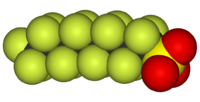
Photo from wikipedia
Contamination by per- and polyfluoroalkyl substances (PFASs) is of great concern in global environments. Due to strong regulation of legacy PFASs, emerging PFASs including alternatives and precursors have been introduced… Click to show full abstract
Contamination by per- and polyfluoroalkyl substances (PFASs) is of great concern in global environments. Due to strong regulation of legacy PFASs, emerging PFASs including alternatives and precursors have been introduced to the industrial market. In this study, legacy and emerging PFASs were measured in seawater, sediment, and bivalves collected along the Korean coast to investigate the occurrence, distribution, contamination sources, and bioaccumulation potential of PFASs. Wide concentration ranges of legacy PFASs were detected in multiple environmental samples, indicating widespread contamination. C8-based PFASs (e.g., PFOA and PFOS) were still major contaminants in all of the environmental samples. Some precursors, such as 8:2 fluorotelomer sulfonate (8:2 FTS) and N-ethyl-perfluorooctane sulfonamidoacetic acid (N-EtFOSAA), and perfluoro-2-propoxypropanoic potassium 9-chlorohexadecafluoro-3-oxanonane-1-sulfonate (F-53B), an alternative to PFOS, were detected in sediment or bivalve samples, implying a shift in consumption patterns from legacy to emerging PFASs. The highest concentrations of PFASs in environmental samples were found at the locations near industrial complexes, such as those for the semi-conductor, paper mill, automobile, and metal-plating industry. This result indicates that PFAS contamination is associated with intensive industrial activities in the coastal environment. Matrix-dependent contamination and profiles of PFASs were observed. Seawater was dominated by short-chained PFASs as a prompt reflection of regulation, while the sediment and bivalves were dominated by long-chained PFASs. Carbon-chain length was a major factor governing environmental behavior and bioaccumulation of PFASs. This was the first nation-wide survey on legacy and emerging PFASs in the coastal environment of Korea.
Journal Title: Chemosphere
Year Published: 2020
Link to full text (if available)
Share on Social Media: Sign Up to like & get
recommendations!